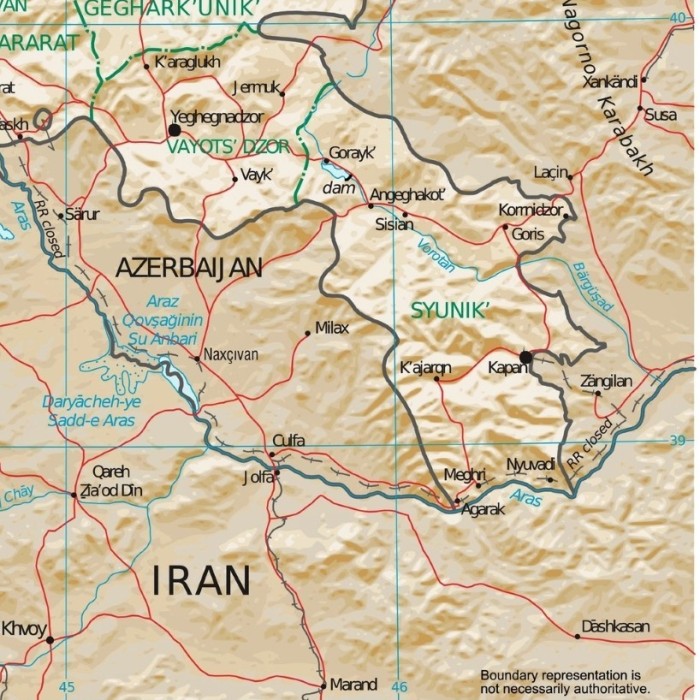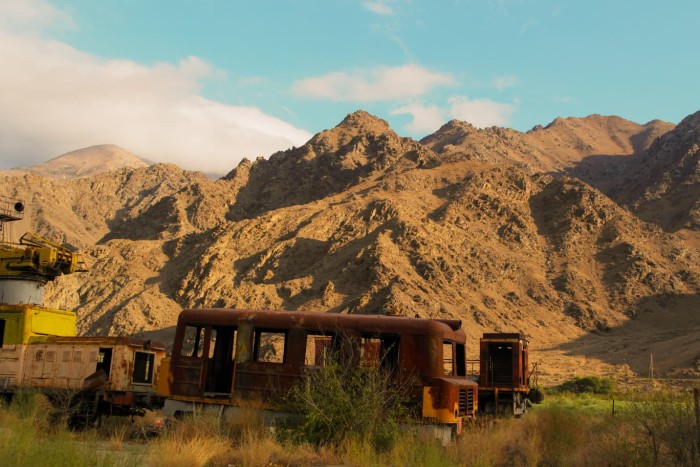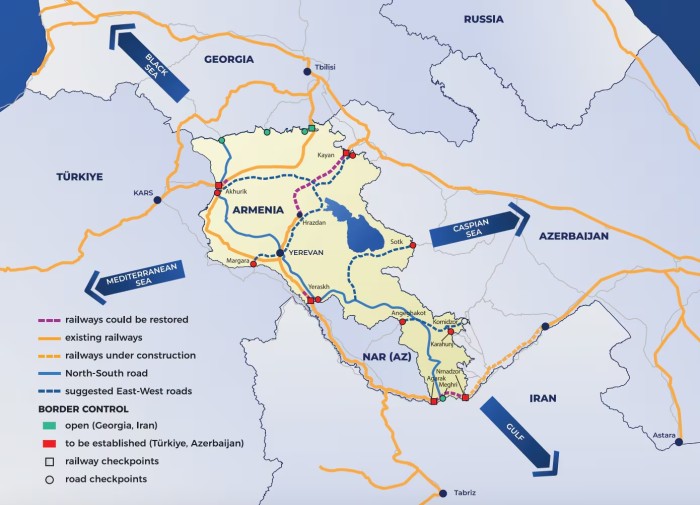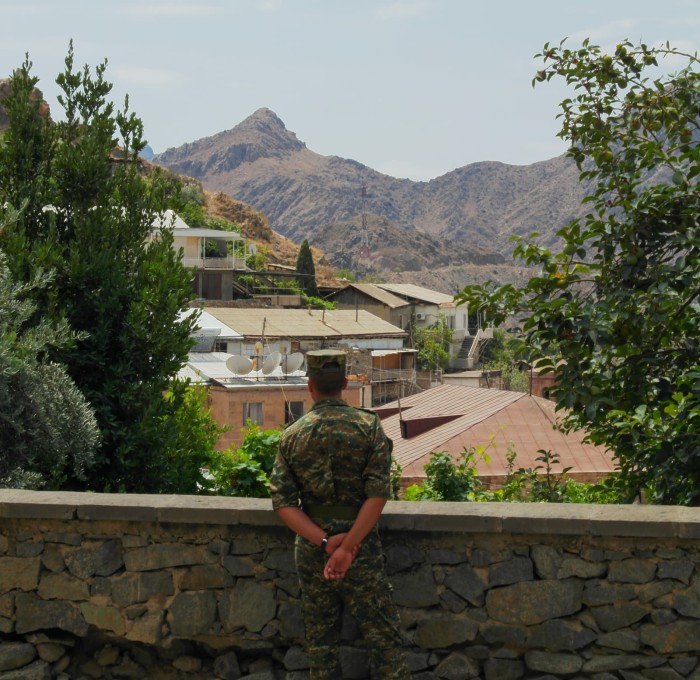Meghri is a small town in the far south of Armenia’s Syunik region, in a crucial location for Armenia. The town is lying just a few kilometers from the Iranian border, the shortest state frontier for both Armenia and Iran.
The city is built in a harsh and barren valley, surrounded by the mountains that also form the border with the Azerbaijani exclave of Nakhijevan. A city known for fruit production, an important mining industry, and a small hub for tourists coming from Iran, thanks to the visa-free regime between the two countries.
It is thought that it is here, next to the Agarak-Norduz border crossing, that the recently announced “Trump Route for International Peace and Prosperity” (TRIPP) should pass. The US-brokered agreement between Azerbaijan and Armenia was announced on 8 August, with the release of a Joint declaration comprising seven points. (1)
The announcement of this ‘connectivity project’ has been controversial in Armenia, as many people fear it could erode the country’s sovereignty by granting Azerbaijan and Turkey significant control over transit routes on the Armenian territory, therefore increasing their influence in the region and the risk of a takeover of the key routes. Azerbaijan has argued for a “Zangeur Corridor” for a direct connection between Azerbaijan and Nakhijevan (and therefore Türkiye), threatening Armenia of establishing this corridor by force. (2) This is why the word “corridor” has been problematic for the Armenians, and the “TRIPP” project, operated under Armenia’s sovereignty, may sound much better to the Armenian public.

At the same time, Aliyev, continues to refer to the “TRIPP” and "Zangezur Corridor" interchangeably, stressing how it is important for Azerbaijan to have international security guarantees and also underlining that in any case Azerbaijan would have the military capacity to seize the region of Syunik. (3)
The economic benefit of this connectivity project is clear for Azerbaijan and Türkiye, which would benefit from being connected to the rest of the Turkic world, and at the same time Armenia can use this occasion to stop its isolation and be one step closer towards it proposal of Crossroads for peace, (4) creating a North-South and East-West connection and restoring economic cooperation in the area.
Beyond economics, TRIPP signals an important shift: by granting the United States development rights under Armenian sovereignty, the agreement is bringing Western influence into the South Caucasus in an unprecedented way.
Nonetheless, reciprocity between the parties remains a problem. It is stated in the Joint declaration that “efforts are to include unimpeded connectivity between the main part of the Republic of Azerbaijan and its Nakhchivan Autonomous Republic through the territory of the Republic of Armenia, but there are still no guarantees that also Türkiye would open their other land borders to Armenia.
Railway connectivity is also crucial. For much of the 20th century, Meghri was not as isolated as it feels today, until 1992, Meghri used to be connected to the rest of Armenia through a railway that was running next to the river Arax, but nowadays this connection passes mostly through Nakhijevan.

On the way which runs along the border, next to a popular viewpoint on the Arax river and the Iranian-Armenian border, a couple of guards overlook the road leading to the abandoned train station of Meghri.
What used to be one of the most important railway connections for trade in the whole of Armenia, is now in ruins.
On the abandoned and rusting carriages, it is still possible to see the Soviet emblems, which are a reminder of when the train used to run directly from Yerevan to Baku.
The core initiative of “Crossroad for peace” lies in this idea: reopen the Soviet transport links together with new ones, in order turn the country into a transit hub. The North–South highway, which aims to connect Iran in the south to Georgia's Black Sea ports in the north, and improve the connection East-West. This crossroads between the Black Sea, Mediterranean, Caspian, and Persian Gulf would turn Armenia into a crucial gateway, and also foster economic and political collaboration in the region.
The future possibility of reopening all these connections would mean a lot to Armenia: Prime Minister Nikol Pashinyan declared that railway transport will not be limited to the “Trump Road” but will also run through other routes, including Georgia and Russia. “Armenian Railways” is managed by the Russian company South Caucasus Railway (SCR) and Russia might invest in restoring railway lines, if Azerbaijan agrees. (5)

Pashinyan also added that Armenia should develop a railway connection with Iran, something that never happened before. Nowadays the Agarak-Norduz crossing is the only road from which Armenia can commerce with Iran, and this importance for Iran has provided a security buffer against Azerbaijan’s military action. Just 50 kilometers away from the Norduz crossing between Iran and Armenia border, there is the only railway bridge on the Arax river, which used to connect Nakhijevan and Iran.
Here, during the Second World War, more than one third of total U.S supplies arrived in the USSR thanks to the Lend-Lease program. (6) Nowadays the border is closed, similarly to all the other land borders of Azerbaijan.
Meanwhile, the Armenian-Iranian border is a key passage, since Iran is a crucial strategic and economic partner in the region.
According to data from the Armenian Statistical Committee (SC), Iran ranked Armenia’s 4th largest trade and economic partner in 2024, and shows that bilateral trade increased by 6.5 percent compared with 2023. (7) While Armenia is not structurally dependent on Iran, more than 30% of Armenia’s trade passes through the Islamic Republic. (8)
On the 19th of August 2025, Armenia and Iran’s leader met in Yerevan to deepen their partnership and discuss the recent events. (9) The new plans include widening the existing Meghri–Norduz bridge and building a second bridge to ease cargo traffic.
The opening of Armenian-Azerbaijani borders would mean a lot for many different actors in and outside the region: a direct connection to Central Asia through the Caspian Sea would mean the creation of a new “Middle corridor” connecting China to the West, in competition with the actual northern corridor that passes through Georgia. At the same time, the connection worries Iran, which is scared that American involvement near its border could limit its access to Russia and Europe.
The importance of this border proved important for Iran also in another occasion: the recent conflict between Iran and Israel in June 2025. (10)
The city of Meghri was at the center of an numerous fleet of Iranian and foreign nationals that seeked security through this narrow passage to the North, showing that, in case of future conflicts, this area might face an influx of thousands of refugees from northern Iran, including many Ethnic Armenians of Iranian nationality. This is also why the position of Meghri can be seen as an important gateway, since it is not just a border town, but the crucial crossing point where the South Caucasus and the Middle East meet and interact.
This is also connected to one of the the strategic dilemmas of Armenia: it relies both on Iran and the U.S. as strategic allies, lying in a risky but relevant position for both parts. On one side, the U.S wants to have a bigger role in the South Caucasus, by trying to ensure stability in an area that is a key trade route to the East, and also a strategic region in which to challenge the dominance of Iran and Russia. On the other side, Iran sees any Western involvement in the region unfavorably, but shares interests with Russia in creating a North-South corridor passing through the South Caucasus.
Therefore, putting effort in balancing neutrality and trying to reach agreements on different tables with all the actors might be the only way in which Armenia can see its security guaranteed and have relevant prospects of needed economic growth and international cooperation. This flexible approach would be important for Armenia also because building a network of relationships is safer instead of relying on just one ally, which Russia was thought to be until a few years ago.
One can see the historical importance of this alliance also on the Armenian-Iranian border, where, following an agreement signed in 1992, Russian border patrol the border. The basis of these forces are four divisions stationed in Gyumri, Artashat, Armavir and Meghri, which consist of approximately 4500 professional soldiers. (11)
But Armenia recently started to retake control of its checkpoints, and today only Armenian guards control all the checkpoints in and out of the country. (12)
Nonetheless, Armenia still relies on the EAEU (Eurasian Economic Union) for trade, and it is heavily dependent on Russia for gas and oil imports and other key commodities like wheat and flour. The same is also true for export, with Russia being the biggest buyer of Armenian goods. Moreover, Russia is the biggest investor in Armenia, also owning the Armenian railways, a big share of the Armenian mining sector and key gas infrastructure. (13)
Traditionally Armenia saw Russia as its most important and reliable ally, but things really changed in the last years. When the war in Nagorno-Karabakh began in 2020, many Armenians expected Russia, at that time the country’s main ally, to step in. Nevertheless, Moscow stayed out, watching as Azerbaijan took back large areas of the region, intervening only to negotiate a ceasefire agreement. Later again, in 2023, Azerbaijan imposed a blockade on Artsakh, cutting off access to food, medicine, and other essentials. Thousands of Armenians were trapped and forced to flee their homes. Russian peacekeepers, whose mandate was to ensure security and protect civilians under the 2020 ceasefire agreement, did not intervene to stop the blockade. Their inaction and complicity caused widespread criticism and made many Armenians realize that Russia was not a reliable ally and security guarantor.
The silence of 2020 and 2023 marked the beginning of a turning point, when Armenia started to rethink its future and the partners it could truly depend on. That is why, Russia, which used to have a virtual influence monopoly on the South Caucasus, nowadays looks like the main loser in the latest changes. It lost its exclusive influence and after failing to establish a durable peace, it failed to stop its strategic rivals from expanding their role in the South Caucasus: Turkey, Azerbaijan and the West are taking their opportunity to get involved and expand their role in the region. Nonetheless, it is still true that Armenia needs to keep good relations with the Russian Federation because of its political and economic involvement in the country.

It is evident how Armenia lies in such a complex position, and the one place that brings these complexities together may be Meghri, which is much more than a quiet town at the edge of Armenia. One can see it just by walking in its streets: plenty of trucks cross the border from Iran every day, soldiers and border guards walk around the city and an old railway station that is left as a reminder of all the past connections, which now could slowly return.
It is here, in Meghri, that many of the challenges and hopes of Armenia come together.
Reference
(1) Full text of US-brokered Armenia-Azerbaijan joint declaration, Armenpress (2025, August 8)
(2) Armenia condemns Aliyev’s threats, «Ազատ Եվրոպա/Ազատություն» Ռադիոկայան (2021, April 21)
(3) Farhadova, A., Aliyev says he still wants the ‘Zangezur corridor’, claiming it would also benefit Armenia, OC Media (2025, August 27)
(4) The Crossroad of Peace Initiative, Government of Armenia, (October 2023)
(5) Pashinyan says “Trump Route” could spur cooperation in Armenia and South Caucasus among countries with strained relations, Armenpress, (2025, August 9)
(6) The Middle Corridor and Armenia’s northern route, RCSP (2025, June 13)
(7) External trade database / Statistical Committee of the Republic of Armenia,
(8) Արտաքին հատված, Statistical Committee of the Republic of Armenia,
(9) Ostiller, N. Pashinyan meets with Iranian President Pezeshkian in Yerevan, OC Media (2025, August 19)
(10) Iranians & Foreign Nationals Flee to Armenia as Border Crossings Surge Amid Escalating Iran–Israel Conflict and Growing Regional Uncertainty, Zartonk Media (2025, June 18)
(11) Agnieszka Rogozińska, Aleksander Ksawery Olech, Report: The Russian federation’s military bases abroad Institute of New Europe
(12) From March 1, solely Armenian Border Guard Troops to control all entry and exit points of Armenia, announces Pashinyan, Armenpress (2025, February 28)
(13) Armenia’s Economic Dependence on Russia: How Deep Does It Go? EVN Report (2023, December 18)

